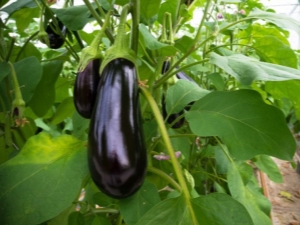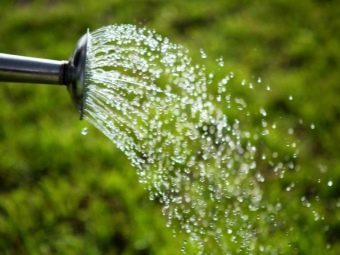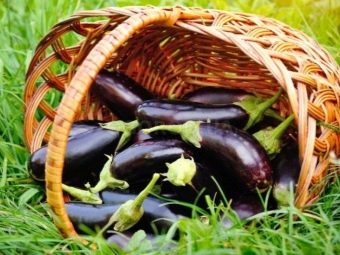How often to water eggplant in the greenhouse?

For each vegetable culture has its own farming. One of the key components of care is watering.Adequate amount of water and regular hydration is essential for full development. In the article we will describe how to properly water the eggplants in a greenhouse built from polycarbonate.
Introduction
Some vegetable crops grown on the territory of the country actively bear fruit in a warm and fairly humid climate. These include eggplant. It is very difficult to achieve a rich harvest in the northern regions of the country, as well as in the middle lane. Changeable weather conditions, cooling, short summer and light day - all this has a negative impact on the development and fruiting of the plant.
To protect the flora from the vagaries of bad weather and to gather a rich harvest, vegetable growers protect fruit crops with the help of buildings made of durable and lightweight material - polycarbonate. On the basis of greenhouses and greenhouses, you can create optimal conditions, regardless of the weather outside the window. In an artificially created microclimate, you need to know how often to water the vegetables.
Plant characteristic
Before talking about the features of irrigation, it is necessary to give a description of this vegetable crop. Residents of the southern regions call this plant "blue." Fruits possess not only remarkable taste, but also a number of useful microelements. Few people know that the well-known vegetable from the family of the nightshade has a tropical origin. For this reason, the plant does not tolerate the climate features of the northern country.
Eggplants need careful care. To obtain a rich and stable harvest, you must adhere to strict agricultural practices in the process of planting and growth. The culture is very similar to sweet pepper in terms of its cultivation.
These are light-loving plants, so the overcast weather and lack of sunlight adversely affect the development of the plant and the quality of the fruit. Vegetables can ripen for a long time and have small sizes.
Also, vegetable culture needs abundant watering. A sufficiently moist soil is a prerequisite for growth and yield. With a shortage of water, the growth process is significantly slowed down, the number of inflorescences decreases, and the size of the fruit leaves much to be desired.
The first watering eggplant
For the first time, water is poured on previously prepared beds intended for planting seedlings. Remember that during this period the plants are still small and do not require a large amount of moisture.
The main thing in this process is to adhere to a certain order.
- Watering the land is carried out using a watering can. On one square meter of a site use 5 liters of water. The fluid must be fully absorbed into the soil.
- With the help of improvised means shallow pits for seedlings are harvested. Use shovels, cuttings and other tools.
- On one hole - one sapling. When planting, pinch off 1/3 of the bottom of the root.
- The soil around the plants must be carefully compacted.
- The land is mulched. Peat is used for this, as well as shredded bark of trees.
- The plants are watered with warm water a second time, in the late afternoon. The volume of water is the same.
- Further watering is carried out once a week. In the hot season, if necessary, the volume of water and the frequency of irrigation can be increased.
Bloom
If the plant began to bloom, it is time for special care. During this period, the culture needs not only watering, but also fertilizing. For fertilizers, various compositions of chemical and organic origin are used. Products must be alternated and combined with watering.
Once in 7 days it is necessary to fertilize the plants according to the following scheme:
- the site is moistened using 5 liters of warm water per square meter of plantings;
- when the earth completely absorbs the liquid, it is necessary to water the feeding mixture in the same quantity;
- upon completion of work it is necessary to loosen the ground slightly or to mulch;
- when using dry fertilizers of organic origin, increase the volume of water to 15 liters.
Fruiting
Every experienced summer resident knows that the appearance of ovaries is a signal for increasing the frequency of watering the plant. During this period, moisture plays a particularly important role in the process of the formation of the future fetus. Abundant watering is necessary for the plant for a rich harvest.
During the fruiting eggplant should be watered 2 times a week. On one bush use a maximum of 3 liters of liquid, and this is 15 liters of water per square meter of plantations.
As soon as the vegetables begin to ripen, you need to cut the amount of fertilizing. Two weeks before harvesting, you should completely stop feeding.
The rules of the rich harvest
To grow eggplants in certain regions of the country is very problematic, but with due diligence you can achieve excellent results.
Experienced experts share recommendations that will help get a rich harvest of tasty and healthy vegetables.
- The first rule - carefully choose seedlings. There are many different varieties with certain characteristics. Do not be lazy to compare the pros and cons of each type to make the right choice, taking into account the particular local climate.
- Monitor the state of the greenhouse or greenhouse. There should be no drafts inside the building. Be sure to install additional light sources. In regions with severe winters can not do without heating.
- Do not overdo it with watering and fertilizing. An excess of moisture and nutrients will negatively affect the condition of the plant.
- Do not experiment with fertilizers. Use only established recipes or purchase ready-made solutions, in abundance presented by stores.
- Inspect the plants for symptoms of disease. If you find small defects, take appropriate measures.
Useful tips
Specialists from the field of agricultural engineering pay special attention to the problem of irrigation of capricious vegetable crops in greenhouse conditions.
Despite the fact that gardeners adhere to a strict scheme of soil moistening, there is a list of factors that affect the frequency of irrigation:
- climatic conditions within a particular region;
- plant variety;
- age of eggplant;
- acidity and soil composition.
It is necessary to maintain a middle ground. Excessive moisture will cause rotting of the root system and the death of your plant. Lack will cause poor yield. The soil in which the eggplants grow should always be moisturized to the best of the measure.
The plant has heavy pollen. Due to this, it is difficult for a vegetable to pollinate on its own in conditions of high humidity. Some growers are advised to specifically shake the plant in the flowering process or distribute pollen using a brush.
Features Mulching
Mulch is necessary to maintain optimum soil moisture. An additional layer will prevent drying and crust formation on the surface. It is necessary to carry out mulching 10-12 hours later after moistening the soil.
There are many options for mulch. Each gardener chooses the best option, however, experts recommend using these materials: sawdust, mowed grass, straw, pine needles, newspapers. Find these components is not difficult.
Soil in greenhouses and greenhouses needs additional feeding before laying mulch. Peat and humus are introduced into it. Experienced gardeners advise to change the soil every 3 years to achieve maximum fruiting.
How to grow eggplants in the greenhouse, see the video below.






























